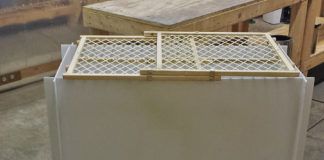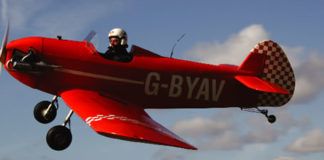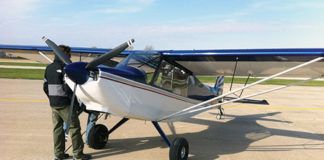Can you think of a task that seems more mundane than making holes? (Sorry, were not going to take up the discussion of match drilling, deburring, riveting or priming…not today.) Its one of those things that a lot of people need to do, and there are a number of different ways to do it. Not everyone has the need or desire for a panel filled with flashy glass screens-devices that carry a surprising benefit: They can reduce the number of panel cuts you, the lucky builder, gets to make. And even if you go the EFIS route, its likely you’ll still need some sort of round hole or two in the panel.
Square holes are, I think, relatively easy-if time consuming to create. Just get a saw, nibbler or die grinder, and cut out the hole. Quick hint: Start the corners of your square holes with a smaller hole drilled with a regular drill bit. This ensures proper strain relief in the corners, as there should never be any 100% square corners in metal; they invite places for cracks to start. (For that matter, Id like to send you back to Bob Fritzs March, 2008 Home Machinist installment on the various ways to cut rectangular holes in sheet metal.)
Back to round holes. There are actually several different methods for cutting them into sheet aluminum. Not everyone has the computers skills, ability, or budget to try and learn a computer-aided drafting program (CAD) so as to cut holes in a panel (to say nothing of the need to send the panel out to someone with the machinery, wait for it to come back and hope its right). Sure, having a panel cut by a computer is about the most accurate you can get, but its just not necessary for a lot of people. We prefer the laser-cut panels, but still need to cut a round hole the old-fashioned way once in a while. Lets take a look at the various ways this can be done.
The Knockout Punch
This punch is basically a three-piece tool made of a male punch, a female die and a bolt to draw the two together. The punches are available in a variety of sizes and shapes from very small holes to very large holes. They are also available for hydraulic power units, but most commonly one would just use a ratchet or other device for drawing the two pieces of the punch together with the bolt that goes through the middle.
Heres what you do. First, drill a pilot hole the size of the bolt in the center of the desired cutout. Next, position the two halves of the punch/die on each side of the panel. Lastly, insert the bolt through the die and panel, and then simply draw the two halves of the punch together until it has completely cut out the desired hole.
Easy, huh? One caution when using knockout-style punches is that they work only for a narrow range of panel thicknesses. For thin panels the punches can warp the material, and on thick panels the punches may be difficult to properly use. Optimally, these types of punches should be employed on aluminum panels that are from 0.032 to 0.100 inch thick. Any thicker or thinner, and you should probably resort to another method. The most common manufacturer of knockout punches is Greenlee, which is owned by a familiar name in our industry, Textron. At about $150, the cost is high for the size of hole (2.25 or 3.125 inch) typically needed. It is an expensive tool for just making a couple of holes, and you’ll find that many of your local EAA chapters will either have one you can borrow, or will know someone who does.
The Hole Saw
The hole saw is the typical wood boring hole saw that youd use when working on your house. They are available in many sizes and can be reasonably priced. Fair warning, however: Do not use the really cheap import ones with the hacksaw-type blades in them. Use the higher quality, heavier duty hole saws. They cost more, but they do a much better job. Hole saws have the advantage that you can drill almost any thickness of panel. Best practice for using a hole saw is to clamp your panel (or other piece of aluminum) securely to the bed of your drill press. Set your drill on the lowest speed possible, and go slowly. Using a good lubricant such as Boelube or beeswax will make the cutting process much easier on both your ears and the hole saw itself. Hole saws are available from many sources including home improvement stores with prices in the $50 range for both the hole saw and mandrel, which you do need.
The Fly Cutter
This tool is also known as a circle cutter. Many people are afraid to use these tools, but if you respect them and are careful, they can be wonderful devices for cutting nice holes in any size material without much hassle. The fly cutter is an adjustable cutting tool that allows you to cut holes (circles) in wood or aluminum in sizes from about 7/8 to 4 inches. They are available in other sizes, but those are the most common. They are typically used in a drill press, and as with the hole saw, your panel or piece of metal needs to be firmly and accurately secured-and be as flat or perpendicular to the cutter as possible.
Many builders have almost lost a finger or severely gashed their limbs when the cutter catches on the metal piece and commences to spinning the sharp chunk around and around! Its imperative that the fly cutter be run at the slowest speed possible on your drill press.
The fly cutter has a centered drill bit to drill the pilot hole, but the adjustable arm that holds the cutting blade is not balanced and is normally only on one end of the adjustable bar. (There are higher priced double bit circle cutters available, but they’re not necessary for the holes were talking about.) If the tool is spun much faster than 500 rpm, it will shake your drill press severely, and you risk ruining your panel, the tool and possible injuring yourself.
Again, cutting fluid such as Boelube will ease this process. And once more, its important when drilling holes with a fly cutter to go slow. Do not try to force the tool through the metal, or it will either catch the metal part and cause the drill to slip or, if you have a heavy duty drill press, you may break the tool and severely disfigure your panel.
The fly cutter might take several minutes to cut through the panel. It works by removing (almost scratching) a small amount of material with each revolution, so be gentle! Also a word of caution: Because the cutter usually makes the hole at a slight bevel, the resultant hole and leftover plug are very sharp, and great care should be taken when working on these holes until they can be deburred or smoothed out. Lastly, the tool can generate a good amount of heat, so be wary of possible burns.
Overall, this is probably the most economical and easiest way to cut holes of infinite size. We frequently use these tools, and with proper use/care you’ll learn to like this tool. They are available from many woodworking supply places, along with your favorite aviation tools supply company and online for about $20 to $40. Again, pay attention to the quality of the tool. There are some cheap ones available, but in this case you might get what you pay for.
The Old-Fashioned Way
Say you need to cut a hole and you don’t have a fly cutter, hole saw, knockout punch or laser handy-and you don’t want to spend the money on any of the above. What do you do? If you have a nibbler, you could drill a start hole and use the nibbler to get close, finishing up with a file. If you don’t have a nibbler or other tool, the choice is to do it the slow way. Simply draw a circle with a compass or some other device, insert a drill bit into your drill motor, and start drilling holes close together around the entire perimeter of the circle you drew. Itll take a lot of holes depending on the size of bit you’re using, but before you know it you’ll have a ragged-edge hole that you can finish off with a file or sander.
This brings us to the next part of cutting holes. Many instruments can have some sort of cutout or bump in one corner. Altimeters, vertical speed indicators, some gyros and various other instruments will have additional requirements beyond the basic round hole. If the desired cutout is small, you may simply use a small round file and slowly remove the metal you need to get rid of. If you’re careful, you can end up with a cutout that is nearly perfect. The other way is to use a drill bit to remove as much metal as you can, and then use a file to smooth out what is left.
For placement of instrument mounting holes there aren’t many options. The first way is to do it via the manufacturers drawings, and using math/trigonometry on the panel, you can accurately depict where the mounting screws are placed. This takes a lot of time and effort, so I suggest another method.
If you or a friend happen to have a junked instrument laying around, you can use it as a template. We have taken unserviceable airspeed indicators and altimeters, cut off the bezel and used them as templates for the mounting holes after the main hole has been cut. The other way to do it is to use a pre-made instrument hole or panel template. Our favorite, made from metal and about $20, is available from various aircraft parts suppliers. It has templates for the most common instrument hole sizes and is handy to have in your toolbox should you decide to cut multiple round holes. You can also make your own from a piece of paper. By folding the paper you will quickly and easily be able to center the holes appropriately around the main cutout.
Lastly, you need to realize that a standard instrument size is practically nonexistent. Standard 2.25-inch gauges can vary as much as 0.070-inch or more between vendors and instrument types, and its the same story for larger instruments. Its worth your time to actually measure what you’re going to install before cutting the holes. Positioning of screw mounting holes may also vary, so if possible try to have the instruments in hand before you start cutting holes. Another thing Ive said before but cant be said enough: Measure five times and cut once! Always make sure you’ve allotted enough room behind the panel for the instruments to fit. Many people assume they can place the holes right next to each other, only to realize later that the instruments can be significantly larger behind the panel.
If you take your time and are careful, any of the aforementioned methods of cutting round holes will result in a nice finished product. The same methods can be used in other areas of the plane beyond just instrument panels. If you don’t have the time or desire to learn a computer program and enjoy doing things hands on, hand-cutting an instrument panel the old-fashioned way can be a fun and gratifying experience.
If you have specific questions for author Stein Bruch, or have certain projects youd like us to cover, email us at [email protected] with About Avionics in the subject line.













